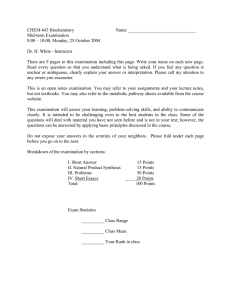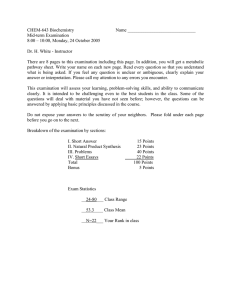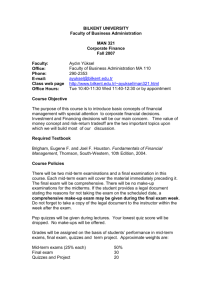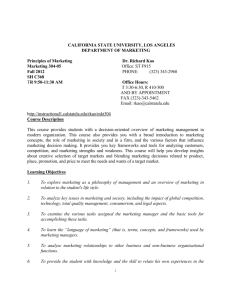CHEM-643 Biochemistry ... Mid-term Examination
advertisement
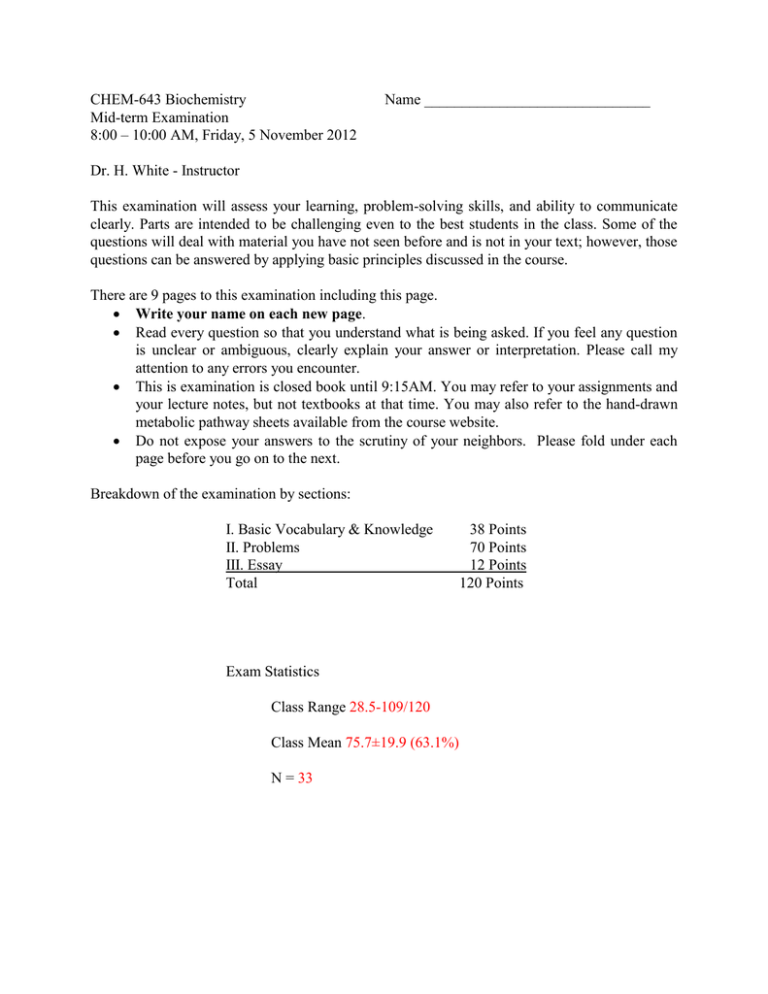
CHEM-643 Biochemistry Mid-term Examination 8:00 – 10:00 AM, Friday, 5 November 2012 Name ______________________________ Dr. H. White - Instructor This examination will assess your learning, problem-solving skills, and ability to communicate clearly. Parts are intended to be challenging even to the best students in the class. Some of the questions will deal with material you have not seen before and is not in your text; however, those questions can be answered by applying basic principles discussed in the course. There are 9 pages to this examination including this page. Write your name on each new page. Read every question so that you understand what is being asked. If you feel any question is unclear or ambiguous, clearly explain your answer or interpretation. Please call my attention to any errors you encounter. This is examination is closed book until 9:15AM. You may refer to your assignments and your lecture notes, but not textbooks at that time. You may also refer to the hand-drawn metabolic pathway sheets available from the course website. Do not expose your answers to the scrutiny of your neighbors. Please fold under each page before you go on to the next. Breakdown of the examination by sections: I. Basic Vocabulary & Knowledge II. Problems III. Essay Total Exam Statistics Class Range 28.5-109/120 Class Mean 75.7±19.9 (63.1%) N = 33 38 Points 70 Points 12 Points 120 Points CHEM-643 Intermediary Metabolism Mid-term Examination, 5 November 2012 Page 2 Name ______________________________ Part I - Basic Vocabulary and Working Knowledge (1 point each) __________________________ 1. Number of carbon atoms in a triterpene. __________________________ 2. Fatty acid precursor for prostaglandins. __________________________ 3. Name for the bicyclic ring system in folic acid. __________________________ 4. Coenzyme associated with carboxylation of β-keto acids __________________________ 5. Disaccharide found in milk __________________________ 6. δ13C value for carbon in the Peedee Belemnite __________________________ 7. Phospholipid not based on glycerol __________________________ 8. Redox cofactor in pyruvate dehydrogenase containing a disulfide. __________________________ 9. Free energy of hydrolysis of AcCoA is similar to that of____. __________________________10. Usual target of end-product inhibition __________________________11. The “T” in TPP stands for_____. __________________________12. The “N” in NAD stands for _____. __________________________13. Six carbon precursor of cholesterol and ketone bodies. __________________________14. Immediate precursor of urea. __________________________15. Coenzyme associated with decarboxylation of α-amino acids __________________________16. Coenzyme associated with decarboxylation of α-keto acids __________________________17. Coenzyme containing cobalt __________________________18. Enzyme containing molybdenum CHEM-643 Intermediary Metabolism Mid-term Examination, 5 November 2012 Page 3 Name ______________________________ Part I: Reactions of oxaloacetate Metabolite Name (20 Points Total). The diagram below shows five metabolites that are connected to oxaloacetate by a single enzymatic reaction. The arrows may but are not intended to indicate reversibility. Please identify the Compounds A to E, the names of enzymes associated with Arrows 1 – 5, any cofactors (if none, so state), and any additional substrates or products needed to create a balanced equation. A. ________________________ B. ________________________ C. ________________________ D. ________________________ E. ________________________ Enzyme Name 1. ________________________ 2. ________________________ 3. ________________________ 4. ________________________ 5. ________________________ Cofactors, if any 1. ________________________ Substrates & Products 1 2. ________________________ 3. ________________________ 4. ________________________ 5. ________________________ 1. ________________________ 2. ________________________ 3. ________________________ 4. ________________________ 5. ________________________ CHEM-643 Intermediary Metabolism Mid-term Examination, 5 November 2012 Name ______________________________ Page 4 Part II: Problems and thought questions 1. L-lactate dehydrogenase (LDH) is A-specific with respect to the prochiral hydrogens at the C-4 position of the pyridine ring of NADH. That is, it will transfer only the HA hydrogen to pyruvate to form lactate. D-glyceraldehyde-3-phosphate dehydrogenase (GAPDH) is specific for the Bposition. GAPDH normally forms 1,3-diphosphoglycerate when phosphate is present. Arsenate will substitute for phosphate in the reaction, but the acyl arsenate formed spontaneously hydrolyzes to regenerate arsenate and form 3-phosphoglycerate. 1-R-3H-Dihydroxyacetone phosphate (DHAP) can be made by incubating 3H2O with unlabeled dihydroxyacetone phosphate and fructose 1,6 bis-phosphate aldolase for an hour and then purifying it chromatographically. Please consider what happens to the 3H in DHAP if it is incubated with the purified enzymes triose phosphate isomerase, GAPDH, and LDH; NAD+ (catalytic amounts), arsenate, and pyruvate, as depicted below. [Biochemistry 10, 2290-2296 (1971)] a. (8 points) Will 2-3H-lactate and/or 3H- NAD+ be formed in the first turnover of NAD3H?, the second? What would be the answer if GAPDH were A-specific? Fill in the following table. turnover B-specific GAPDH first (Actual) second A-specific GAPDH first (Hypothetical) second 3 H-lactate (Yes/No) 3 H-NAD+ (Yes/No) CHEM-643 Intermediary Metabolism Mid-term Examination, 5 November 2012 2. Page 5 Name ______________________________ Over the years, a concept of metabolic repair has emerged. Although most metabolic enzymes are rather specific, they are not perfect and occasionally catalyze the wrong reaction as for example when Rubisco reacts with oxygen rather than carbon dioxide. While you may have heard or read about photorespiration, we have not discussed it in class. Nevertheless, the chemistry of the reactions should be familiar to you. The whole multistep pathway is a metabolic repair pathway that consumes oxygen and generates carbon dioxide while reclaiming a 3PGA from phosphoglycolate (A) as shown below. a. (2 points) Identify compounds D _________________ and E ______________________. b. (8 Points) Reaction 4, which forms E from two molecules of D, is a complex multistep reaction involving reactions we have studied. Without going into excessive detail, outline a reasonable process to explain how this conversion occurs and what would be involved. CHEM-643 Intermediary Metabolism Mid-term Examination, 5 November 2012 Page 6 Name ______________________________ c. (8 Points) Three of the reactions in photorespiration involve pyridoxal phosphate. Select one and show how PLP mechanistically (push electrons) helps catalyze the reaction. Use the back of this page if needed. d. (8 Points) For every CO2 fixed in the Calvin Cycle, 3ATP and 2NADPH generated by the light reactions are used. Analyze the photorespiration pathway and estimate its “cost” in ATP and NADPH per Rubisco “mistake”. Describe your reasoning. e. (4 Points) Salads containing green leafy vegetables are nutritious because they contain high amounts of certain vitamins. Given that enzymes for the reactions of photosynthesis constitute a significant proportion of the protein in leaves, leafy vegetables would be rich in what vitamins? Explain your reasoning. CHEM-643 Intermediary Metabolism Mid-term Examination, 5 November 2012 Name ______________________________ Another metabolic repair process includes two enzymes involved in recovering modified NADH and NADPH that have been hydrated by a side reaction of glyceraldehyde 3-P dehydrogenase (GAPDH) or simply in an acid catalyzed reaction which forms two stereoisomers of NADHX, as shown below. To repair this damage, there are two enzymes—one that equilibrates the R and S forms of NADHX and another that converts S-NADHX back to NADH. This second enzyme requires ATP. [J. Biol. Chem. 286, 41246 – 41251 (2011)] a. (6 Points) Suppose you had an equilibrated sample of NADHX (40%R:60%S) and you incubated it with the isomerase for 30 minutes and then added the dehydrase for an additional 30 minutes while monitoring the formation of NADH. On the grid below, graph the formation of NADH as a function of time. (Assume any reaction would be complete in 30 minutes.) NADH Formation 3. Page 7 0 30 60 Time b (4 Points) If the order of enzyme addition were reversed, would the graph be any different? If so, show how it would be different. CHEM-643 Intermediary Metabolism Mid-term Examination, 5 November 2012 Page 8 Name ______________________________ c (6 Points) Propose a reasonable mechanism for the role of ATP in the dehydration reaction of S-NADHX into NADH. 4. The following is a verbal description of the fermentation of glucose to butyric acid, carbon dioxide, and hydrogen gas by the strict anaerobic bacteria, Clostridium butylicum. Glucose is converted to pyruvate via normal reactions of the glycolytic pathway. The oxidative decarboxylation of pyruvate to form acetyl CoA differs from pyruvate dehydrogenase in that ferredoxin instead of NAD accepts electrons. Reduced ferredoxin in turn reacts with protons to produce hydrogen gas. Two moles of acetyl CoA condense to form acetoacetyl CoA (βketobutyryl CoA) which in turn undergoes β-reduction to butyryl CoA using NADH for both reduction steps. Finally the energy liberated in the thioester cleavage to butyric acid is couple to ATP formation. a. (8 Points) Provide the structures of the chemical intermediates between pyruvate and butyrate showing which coenzymes are involved when they are needed. CHEM-643 Intermediary Metabolism Mid-term Examination, 5 November 2012 b. Page 9 Name ______________________________ Consider the entire pathway from glucose to butyrate, i. (4 Points) How many net ATPs are formed. Compare this to yeast fermentation of glucose to ethanol. ii. (4 Points) Is there a net balance of NADH production and consumption in this pathway? Justify your answer. Party III: Essay Question (12 Points) Brain Teaser. Bears hibernate without food for months at a time but do not get ketotic while ketone bodies rise rather quickly in humans who fast for even a day or two. How might this difference be explained? [FASEB J. 14(4), Abst. 451.5 (2000) discussed by Cahill Annu. Rev. Nutr. 26: 1-22(2006)]
